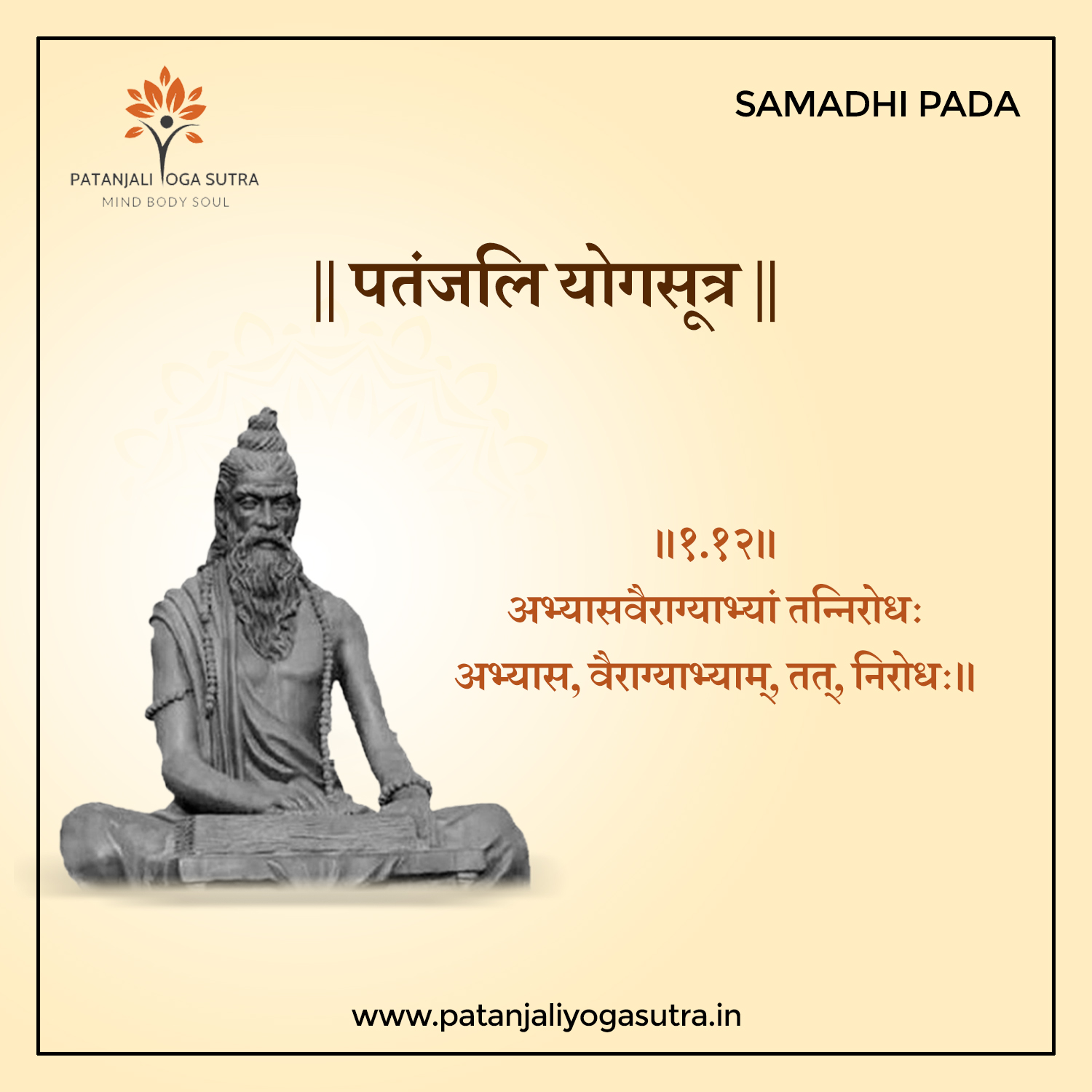



अभी तक हमने योग के अनुशासन, योग की परिभाषा और वृत्तियों के विषय में विस्तार से जाना | यह सूत्र योगदर्शन के महत्वपूर्ण सूत्रों में से एक है | इसका सीधा अर्थ है कि- अभ्यास और वैराग्य के द्वारा वृत्तियों का निरोध हो सकता है अर्थात विचाररूपी तरंगो को सहजता से रोका जा सकता है |
यहाँ हम अभ्यास और वैराग्य को एक एक कर समझने का प्रयास करेंगे क्योंकि यदि इन्हें ठीक से नहीं समझा गया तो योग में उन्नति कदापि सम्भव नहीं है |
मैंने पहले भी लिखा है कि अधिकांशतः योग की परिभाषा और योग में स्थिति हेतु उपायों को गलत समझा गया है |
सीधी भाषा में कहूँ तो अभ्यास का अर्थ है प्रयत्न या पुरुषार्थ |
वैराग्य का अर्थ है सहज पुरुषार्थ या आन्तरिक पुरुषार्थ
अभ्यास से एक ओर हम प्रयत्न पूर्वक या यूँ कहें बलपूर्वक बाहरी चेष्टाएँ कर आचरण की पवित्रता रखते हैं वहीँ दूसरी ओर सहज आन्तरिक पुरुषार्थ से अपने जीवन को सँभालते हैं |
योग सम्पूर्णता का नाम है- यहाँ शरीर भी संभाला जाता है और आंतरिक जीवन भी | स्थूल और सूक्ष्म रूप से जबतक हम प्रयत्नशील नहीं होंगे तब तक योग में गति संभव नहीं है क्योंकि दोनों एक दुसरे के पूरक हैं | यदि आपका शरीर स्वस्थ नहीं है तो आपका योग में प्रवेश ही असंभव है और यदि आप शरीर से कदाचित स्वस्थ लग भी रहे हैं और मन से बीमार हैं तो थोड़े बहुत योग में प्रवेश के बाद आपकी गति विपरीत हो जाएगी और सम्भावना अधिक होगी कि आप पुनः प्रवेश में घबराएंगे |
इसलिए अभ्यास और वैराग्य के माध्यम से हम योग में प्रतिष्ठित होते हैं | यह हमारी क्लिष्ट वृत्तियों अर्थात ऐसी विचारों को सहज ही रोकता है जो हमें दुःख देती हैं, हमारे मन में विचलन उत्पन्न करती हैं |
व्यास भाष्य के अनुसार, चित्त को नदी कहा गया है जो कि दो धाराओं में बहती है | उसकी एक धारा कल्याण के लिए बहती है और दूसरी पाप के लिए | जो धारा कल्याण पथ पर बहती है वह साधक को कैवल्य के मार्ग पर ले जाने वाली है और विवेक-मार्ग पर झुकी हुई है | जो धारा संसार की ओर ले जाने वाली है और अविवेक विषय मार्ग की ओर झुकी हुई है | इन दोनों में से वैराग्य के द्वारा पापवहा धारा सुखाई जाती है और सतत विवेक दर्शन के अभ्यास से विवेक को जगाया जाता है| इस प्रकार चित्त की वृत्तियों का निरोध अभ्यास और वैराग्य के अधीन होता है|
So far we have learnt in detail about Yoga discipline, definition of Yoga and vritties. This Sutra is one of the important Sutras of Yoga Darshana. It simply means that vritties can be controlled through practice and detachment ie thought waves can be easily controlled.
Here we will try to understand practice and detachment one by one because without understanding these two, it is impossible to progress in Yoga.
As mentioned earlier, ‘definition of Yoga’ and’ solution to stages in Yoga’ are mostly misunderstood.
Simply put, practice means effort or attempt.
Detachment means effortless effort or internal effort.
Through practice we maintain sanctity of behaviour by making efforts or forceful external efforts on one hand and on the other we take care of our life through natural internal efforts.
Yoga means entirety. Here body as well as internal life is taken care of. Movement in Yoga is not possible unless we try at the smallest level because both are complimentary to each other. Entry in Yoga is impossible if your body is not healthy. If you look physically healthy but are mentally unwell, then after an initial entry in Yoga your movement will be reversed and there is a greater possibility that you will fear re-entry.
Therefore, through the means of practice and detachment we earn respect in Yoga. It naturally prevents klisht vritties or thoughts that cause sorrow and anxiety in our minds.
As per Vyas commentary mind is a river which flows in two riverine. One riverine flows in the direction of welfare and the other on sinful path. The one that flows on welfare path leads the practitioner to kaivalya, bending on intellect path. The reverine leading to the world and bending on unintellect is made to dry up through detachment and intellect is awoken with the sheer practice of vivek Darshan. Like this modifications of mind are under the control of practice and detachment.
सूत्र: अभ्यासवैराग्याभ्यां तन्निरोधः
अभ्यास वैराग्य की धार से वृत्तियों समूल नाश को पाती हैं
हुई निश्छल जीवात्मा तब स्वयं प्रभु निमग्न हो जाती है।
Really Helpful site. However, not able to listen to explanation from 1.7. Please help so as explanation can be listened for all.
Thank you hina ji..You will get all the explanation audios soon.
we will get it done for you all soon . thanks for the motivation
Good explanation,i m getting my own notes after referring the commentary of others.
Thanks very much